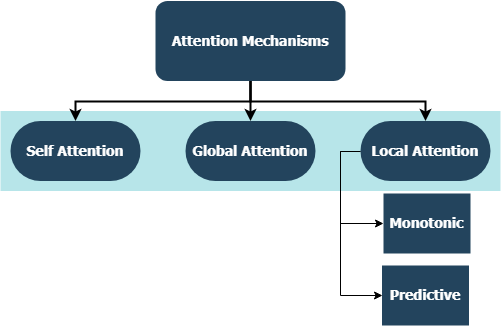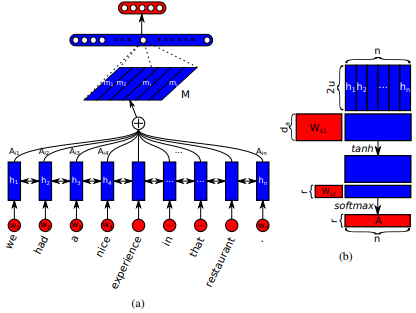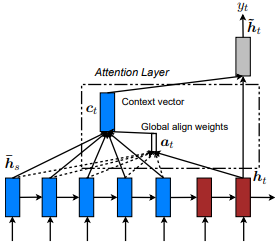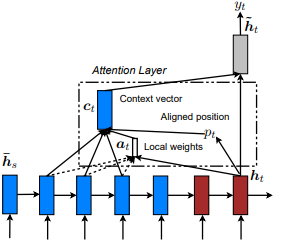- Introduction
- Attention Types
- Alignment Functions
- Implementation Details
- Examples
- Contributing
- Resources
This repository includes custom layer implementations for a whole family of attention mechanisms, compatible with TensorFlow and Keras integration. Attention mechanisms have transformed the landscape of machine translation, and their utilization in other domains of natural language processing & understanding are increasing day by day. In a broader sense, they aim to eliminate the disadvantageous compression and loss of information in RNNs. These originate due to the fixed-length encoding of hidden states derived from input sequences by recurrent layers in sequence-to-sequence models. The layers in this repository can be used for both many-to-many and many-to-one sequence tasks. Applications include sentiment classification, text generation, machine translation, and question answering. It is also worthwhile to mention that this project will soon be deployed as a Python package. Check Contributing subsection on how to contribute to this project.
First introduced in Long Short-Term Memory-Networks for Machine Reading by Jianpeng Cheng et al. The idea is to relate different positions of the same hidden state space derived from the input sequence, based on the argument that multiple components together form the overall semantics of a sequence. This approach brings together these differently positioned information through multiple hops attention. This particular implementation follows A Structured Self-Attentive Sentence Embedding by Zhouhan Lin et al. where authors propose an additional loss metric for regularization to prevent the redundancy problems of the embedding matrix if the attention mechanism always provides similar annotation weights.
First introduced in Neural Machine Translation by Jointly Learning to Align and Translate by Dzmitry Bahdanau et al. The idea is to derive a context vector based on all hidden states of the encoder RNN. Hence, it is said that this type of attention attends to the entire input state space.
First introduced in Show, Attend and Tell: Neural Image Caption Generation with Visual Attention by Kelvin Xu et al. and adapted to NLP in Effective Approaches to Attention-based Neural Machine Translation by Minh-Thang Luong et al. The idea is to eliminate the attentive cost of global attention by instead focusing on a small subset of tokens in hidden states set derived from the input sequence. This window is proposed as [p_t-D, p_t+D] where D=width, and we disregard positions that cross sequence boundaries. The aligned position, p_t, is decided either through a) monotonic alignment: set p_t=t, or b) predictive alignment: set p_t = S*sigmoid(FC1(tanh(FC2(h_t))) where fully-connected layers are trainable weight matrices. Since yielding an integer index value is undifferentiable due to tf.cast() and similar methods, this implementation instead derives a aligned position float value and uses Gaussian distribution to adjust the attention weights of all source hidden states instead of slicing the actual window. We also propose an experimental alignment type, c) completely predictive alignment: set p_t as in ii), but apply it to all source hidden states (h_s) instead of the target hidden state (h_t). Then, choose top @window_width positions to build the context vector and zero out the rest. Currently, this option is only avaiable for many-to-one scenarios.
First introduced in Hierarchical Attention Networks for Document Classification by Zichao Yang et al. The idea is to reflect the hierarchical structure that exists within documents. The original paper proposes a bottom-up approach by applying attention mechanisms sequentially at word- and sentence-levels, but a top-down approach (ex. word- and character-levels) is also applicable. Hence, this type of mechanisms is said to attend differentially to more and less important content when constructing the document representation.
Each function is trying to compute an alignment score given a target hidden state (h_t) and source hidden states (h_s).
| Name | Formula for |
Defined by |
|---|---|---|
| Dot Product | Luong et al. (2015) | |
| Scaled Dot Product | Vaswani et al. (2017) | |
| General | Luong et al. (2015) | |
| Concat | Bahdanau et al. (2015) | |
| Location | Luong et al. (2015) |
where H is the number of hidden states given by the encoder RNN, and where W_a and v_a are trainable weight matrices.
- As of now, all attention mechanisms in this repository are successfully tested with applications in both many-to-one and many-to-many sequence tasks. Check the Examples subsection for example applications.
- It should be noted that there is no claim that the attention mechanisms represented in this repository (and their accompanying hyperparameters represented in Examples subsection) is optimized in anyway; there is still a lot of room for improvement from both a software development and research perspective.
- Every layer is a subclass of
tf.keras.layers.Layer(). - The
__init__()method of each custom class calls the the initialization method of its parent and defines additional attributes specific to each layer. - The
get_config()method calls the configuration method of its parent and defines custom attributes introduced with the layer. - If a custom layer includes method
build(), then it contains trainable parameters. Take theAttention()layer for example, the backpropagation of the loss signals which inputs to give more care to and hence indicates a change in weights of the layer. - The
call()method is the actual operation that is performed on the input tensors. compute_output_shape()methods are avoided for spacing.
These layers can be plugged-in to your projects (whether language models or other types of RNNs) within seconds, just like any other TensorFlow layer with Keras integration. See the below general-purpose example for instance:
from tensorflow.keras.layers import Input, Embedding, LSTM, Dense
from layers import Attention
X = Input(shape=(sequence_length,), batch_size=batch_size) # define input layer for summary
## Token Embedding (Pretrained or Not) ##
embedding = Embedding(input_dim=vocabulary_size, output_dim=embedded_dimensions)(X)
## Encoding Recurrent Layers ##
encoder = LSTM(units=recurrent_units, return_sequences=True)(embedding) # keep timesteps
## Decoding with Attention ##
decoder, attention_weights = Attention(context='many-to-one', alignment_type=attention_type, model_api='functional')(encoder)
## Prediction Layer ##
Y = Dense(units=vocabulary_size, activation='softmax')(decoder)
where alignment_type is one of 'global', 'local-m', 'local-p', and 'local-p*'. For self attention, call the SelfAttention(size=attention_size) layer instead.
Check below subtopics for more examples, analyses, and comparisons. For fair comparison, all compared models utilize similar parameters. For example, a batch size of 100 and a number of epochs of 20 were preferred on some examples.
You can find a sentiment classification (many-to-one, binary) example on IMBD Reviews Dataset inside examples/sentiment_classification.py. This example compares three distinct tf.keras.Model()(Functional API) models (all word-level) and aims to measure the effectiveness of the implemented self-attention layer over the conventional MLP (Multi Layer Perceptron) model. Refer to the below table for metrics:
| Model ID | Maximum Validation Binary Accuracy |
|---|---|
| Simple Multi-Layer Perceptron Model | 0.8730 |
| Simple Multi-Layer Perceptron Model w/ Self-Attention (Non-Penalized) | 0.8907 |
| Simple Multi-Layer Perceptron Model w/ Self-Attention (Penalized) | 0.8870 |
You can find a text generation (many-to-one) example on Shakespeare Dataset inside examples/text_generation.py. This example compares three distinct tf.keras.Model()(Functional API) models (all character-level) and aims to measure the effectiveness of the implemented attention and self-attention layers over the conventional LSTM (Long Short Term Memory) models. Refer to the below table for metrics:
| Model ID | Maximum Validation Categorical Accuracy |
|---|---|
| LSTM Model | 0.5953 |
| LSTM Model w/ Self-Attention (Non-Penalized) | 0.6049 |
| LSTM Model w/ Local-p* Attention | 0.6234 |
You can find a document (news) classification (many-to-one, multi-class) example on Reuters Dataset inside examples/document_classification.py. This example compares four distinct tf.keras.Model()(Functional API) models (all word-level) and aims to measure the effectiveness of the implemented attention and self-attention layers over the conventional LSTM (Long Short Term Memory) models. Refer to the below table for metrics:
| Model ID | Maximum Validation Categorical Accuracy |
|---|---|
| LSTM Model | 0.7210 |
| LSTM Model w/ Self-Attention (Non-Penalized) | 0.7790 |
| LSTM Model w/ Global Attention | 0.7496 |
| LSTM Model w/ Local-p* Attention | 0.7446 |
You can find a machine translation (many-to-many) example on English-to-Spanish Dataset inside examples/machine_translation.py. This example pretty much follows TensorFlow's Machine Translation Example with some adaptions. It compares four distinct tf.keras.Model()(Functional API) models (all word-level) and aims to measure the effectiveness of the implemented attention layer. Refer to the below table for metrics:
| Model ID | Maximum Validation Categorical Accuracy |
|---|---|
| Encoder-Decoder Model | 0.8848 |
| Encoder-Decoder Model w/ Global Attention | 0.8860 |
| Encoder-Decoder Model w/ Local-m Attention | 0.9524 |
| Encoder-Decoder Model w/ Local-p Attention | 0.8873 |
Whether it is bugs you have encountered, performance concerns, or any kind of input you have in mind, this is the perfect time to share them! Check CONTRIBUTING.md for more information and guidelines on this topic.




